Refine search
No keyword found to refine search
keywords EN
Places
Names
21 documents found
| 1 |
Documents per page :

Original Christian holy place of the cave of the Seven Sleepers
Manoël Pénicaud / Le Pictorium
LePictorium_0169801.jpg
Known in Islam as the People of the Cave
(Ahl al-Kahf in Arabic), the Seven Sleepers are said to have miraculously slept for several centuries in a cave in order to escape from the persecutions of the Roman Empire. Their awakening is a metaphor for the resurrection
of the body, in both Christianity and in Islam
(Qur’anic sura ‘The Cave’). The narratives
of the Seven Sleepers were widely disseminated. Numerous caves in the Mediterranean region are considered to be sacred places where this miracle occurred. This legend has sometimes given rise to joint veneration by Christians and Muslims.
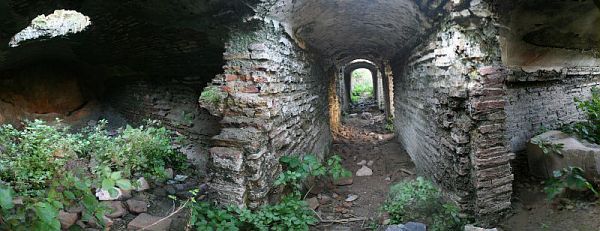
Crypt of the Seven Sleepers in Ephesus
Manoël Pénicaud / Le Pictorium
LePictorium_0169802.jpg
Known in Islam as the People of the Cave
(Ahl al-Kahf in Arabic), the Seven Sleepers are said to have miraculously slept for several centuries in a cave in order to escape from the persecutions of the Roman Empire. Their awakening is a metaphor for the resurrection
of the body, in both Christianity and in Islam
(Qur’anic sura ‘The Cave’). The narratives
of the Seven Sleepers were widely disseminated. Numerous caves in the Mediterranean region are considered to be sacred places where this miracle occurred. This legend has sometimes given rise to joint veneration by Christians and Muslims.
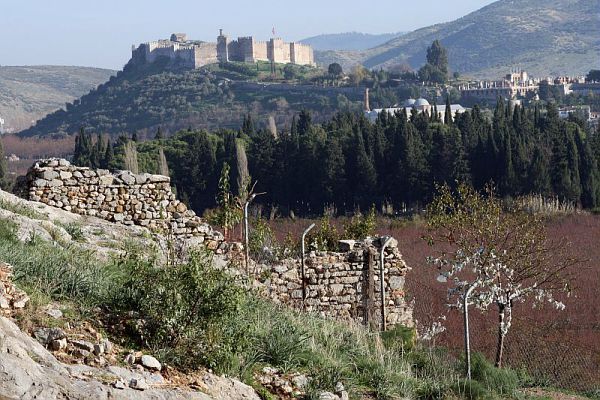
Citadel of Saint John, from the 7 Dormants site, with a wishing tree
Manoël Pénicaud / Le Pictorium
LePictorium_0169803.jpg
Known in Islam as the People of the Cave
(Ahl al-Kahf in Arabic), the Seven Sleepers are said to have miraculously slept for several centuries in a cave in order to escape from the persecutions of the Roman Empire. Their awakening is a metaphor for the resurrection
of the body, in both Christianity and in Islam
(Qur’anic sura ‘The Cave’). The narratives
of the Seven Sleepers were widely disseminated. Numerous caves in the Mediterranean region are considered to be sacred places where this miracle occurred. This legend has sometimes given rise to joint veneration by Christians and Muslims.

Sanctuary of the 7 Sleepers in Tarsus
Manoël Pénicaud / Le Pictorium
LePictorium_0169804.jpg
Known in Islam as the People of the Cave
(Ahl al-Kahf in Arabic), the Seven Sleepers are said to have miraculously slept for several centuries in a cave in order to escape from the persecutions of the Roman Empire. Their awakening is a metaphor for the resurrection
of the body, in both Christianity and in Islam
(Qur’anic sura ‘The Cave’). The narratives
of the Seven Sleepers were widely disseminated. Numerous caves in the Mediterranean region are considered to be sacred places where this miracle occurred. This legend has sometimes given rise to joint veneration by Christians and Muslims.
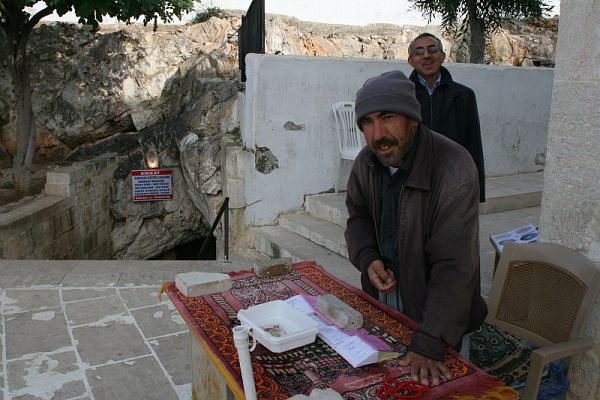
The guardian and the imam of the sanctuary. The second recognizes the Christian past in the history of the Seven Sleepers.
Manoël Pénicaud / Le Pictorium
LePictorium_0169805.jpg
Known in Islam as the People of the Cave
(Ahl al-Kahf in Arabic), the Seven Sleepers are said to have miraculously slept for several centuries in a cave in order to escape from the persecutions of the Roman Empire. Their awakening is a metaphor for the resurrection
of the body, in both Christianity and in Islam
(Qur’anic sura ‘The Cave’). The narratives
of the Seven Sleepers were widely disseminated. Numerous caves in the Mediterranean region are considered to be sacred places where this miracle occurred. This legend has sometimes given rise to joint veneration by Christians and Muslims.

Pilgrims in the Cave of the 7 Dormants
Manoël Pénicaud / Le Pictorium
LePictorium_0169806.jpg
The site is very popular and frequented. For the pilgrims, this is the true place of the miracle.
Known in Islam as the People of the Cave (Ahl al-Kahf in Arabic), the Seven Sleepers are said to have miraculously slept for several centuries in a cave in order to escape from the persecutions of the Roman Empire. Their awakening is a metaphor for the resurrection of the body, in both Christianity and in Islam (Qur’anic sura ‘The Cave’). The narratives of the Seven Sleepers were widely disseminated. Numerous caves in the Mediterranean region are considered to be sacred places where this miracle occurred. This legend has sometimes given rise to joint veneration by Christians and Muslims.
Known in Islam as the People of the Cave (Ahl al-Kahf in Arabic), the Seven Sleepers are said to have miraculously slept for several centuries in a cave in order to escape from the persecutions of the Roman Empire. Their awakening is a metaphor for the resurrection of the body, in both Christianity and in Islam (Qur’anic sura ‘The Cave’). The narratives of the Seven Sleepers were widely disseminated. Numerous caves in the Mediterranean region are considered to be sacred places where this miracle occurred. This legend has sometimes given rise to joint veneration by Christians and Muslims.

The pilgrims aim at receiving drops of water that pear from the ceiling of the cave
Manoël Pénicaud / Le Pictorium
LePictorium_0169807.jpg
Known in Islam as the People of the Cave
(Ahl al-Kahf in Arabic), the Seven Sleepers are said to have miraculously slept for several centuries in a cave in order to escape from the persecutions of the Roman Empire. Their awakening is a metaphor for the resurrection
of the body, in both Christianity and in Islam
(Qur’anic sura ‘The Cave’). The narratives
of the Seven Sleepers were widely disseminated. Numerous caves in the Mediterranean region are considered to be sacred places where this miracle occurred. This legend has sometimes given rise to joint veneration by Christians and Muslims.

The pilgrims aim at receiving drops of water that pear from the ceiling of the cave
Manoël Pénicaud / Le Pictorium
LePictorium_0169808.jpg
Known in Islam as the People of the Cave
(Ahl al-Kahf in Arabic), the Seven Sleepers are said to have miraculously slept for several centuries in a cave in order to escape from the persecutions of the Roman Empire. Their awakening is a metaphor for the resurrection
of the body, in both Christianity and in Islam
(Qur’anic sura ‘The Cave’). The narratives
of the Seven Sleepers were widely disseminated. Numerous caves in the Mediterranean region are considered to be sacred places where this miracle occurred. This legend has sometimes given rise to joint veneration by Christians and Muslims.
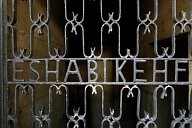
Door of the minaret of the sanctuary. Eshab i-Kehf means the "Companions of the Cave" to designate the Seven Sleepers
Manoël Pénicaud / Le Pictorium
LePictorium_0169809.jpg
Known in Islam as the People of the Cave
(Ahl al-Kahf in Arabic), the Seven Sleepers are said to have miraculously slept for several centuries in a cave in order to escape from the persecutions of the Roman Empire. Their awakening is a metaphor for the resurrection
of the body, in both Christianity and in Islam
(Qur’anic sura ‘The Cave’). The narratives
of the Seven Sleepers were widely disseminated. Numerous caves in the Mediterranean region are considered to be sacred places where this miracle occurred. This legend has sometimes given rise to joint veneration by Christians and Muslims.

Bus (Dolmush) to go the sanctuary
Manoël Pénicaud / Le Pictorium
LePictorium_0169810.jpg
Known in Islam as the People of the Cave
(Ahl al-Kahf in Arabic), the Seven Sleepers are said to have miraculously slept for several centuries in a cave in order to escape from the persecutions of the Roman Empire. Their awakening is a metaphor for the resurrection
of the body, in both Christianity and in Islam
(Qur’anic sura ‘The Cave’). The narratives
of the Seven Sleepers were widely disseminated. Numerous caves in the Mediterranean region are considered to be sacred places where this miracle occurred. This legend has sometimes given rise to joint veneration by Christians and Muslims.
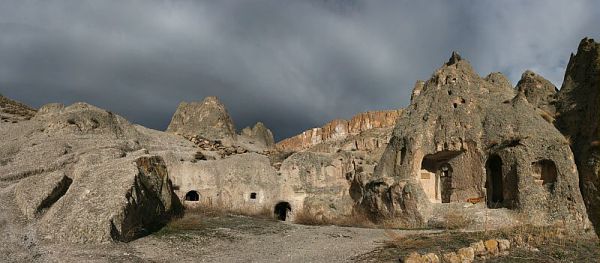
Rock church of Santa Barbara (Tahtali) with a fresco representing three of the Seven Sleepers
Manoël Pénicaud / Le Pictorium
LePictorium_0169811.jpg
Known in Islam as the People of the Cave
(Ahl al-Kahf in Arabic), the Seven Sleepers are said to have miraculously slept for several centuries in a cave in order to escape from the persecutions of the Roman Empire. Their awakening is a metaphor for the resurrection
of the body, in both Christianity and in Islam
(Qur’anic sura ‘The Cave’). The narratives
of the Seven Sleepers were widely disseminated. Numerous caves in the Mediterranean region are considered to be sacred places where this miracle occurred. This legend has sometimes given rise to joint veneration by Christians and Muslims.
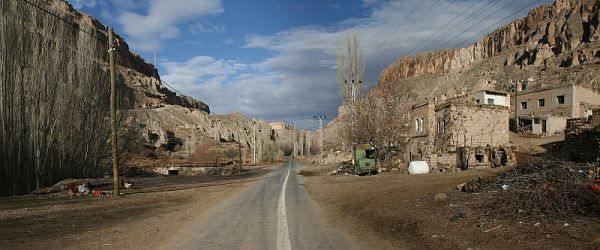
A Cappadocian Road, Soganli Valley
Manoël Pénicaud / Le Pictorium
LePictorium_0169812.jpg
Known in Islam as the People of the Cave
(Ahl al-Kahf in Arabic), the Seven Sleepers are said to have miraculously slept for several centuries in a cave in order to escape from the persecutions of the Roman Empire. Their awakening is a metaphor for the resurrection
of the body, in both Christianity and in Islam
(Qur’anic sura ‘The Cave’). The narratives
of the Seven Sleepers were widely disseminated. Numerous caves in the Mediterranean region are considered to be sacred places where this miracle occurred. This legend has sometimes given rise to joint veneration by Christians and Muslims.

Soganli Valley and the Church of Santa Barbara (Tahtali)
Manoël Pénicaud / Le Pictorium
LePictorium_0169813.jpg
Known in Islam as the People of the Cave
(Ahl al-Kahf in Arabic), the Seven Sleepers are said to have miraculously slept for several centuries in a cave in order to escape from the persecutions of the Roman Empire. Their awakening is a metaphor for the resurrection
of the body, in both Christianity and in Islam
(Qur’anic sura ‘The Cave’). The narratives
of the Seven Sleepers were widely disseminated. Numerous caves in the Mediterranean region are considered to be sacred places where this miracle occurred. This legend has sometimes given rise to joint veneration by Christians and Muslims.

Church of St. Barbara with a fresco depicting three of the Seven Sleepers and the Nativity scene
Manoël Pénicaud / Le Pictorium
LePictorium_0169814.jpg
Known in Islam as the People of the Cave
(Ahl al-Kahf in Arabic), the Seven Sleepers are said to have miraculously slept for several centuries in a cave in order to escape from the persecutions of the Roman Empire. Their awakening is a metaphor for the resurrection
of the body, in both Christianity and in Islam
(Qur’anic sura ‘The Cave’). The narratives
of the Seven Sleepers were widely disseminated. Numerous caves in the Mediterranean region are considered to be sacred places where this miracle occurred. This legend has sometimes given rise to joint veneration by Christians and Muslims.
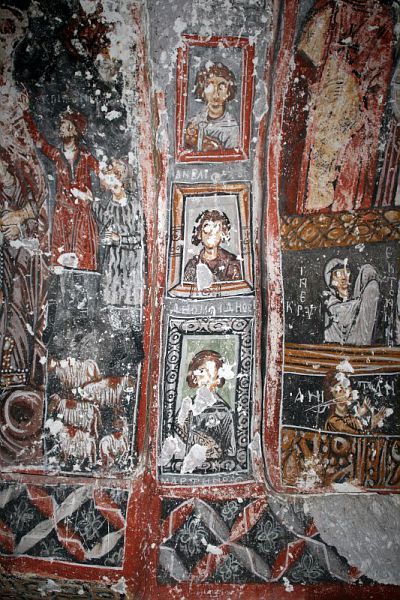
Church of St. Barbara with a fresco depicting three of the Seven Sleepers
Manoël Pénicaud / Le Pictorium
LePictorium_0169815.jpg
Known in Islam as the People of the Cave
(Ahl al-Kahf in Arabic), the Seven Sleepers are said to have miraculously slept for several centuries in a cave in order to escape from the persecutions of the Roman Empire. Their awakening is a metaphor for the resurrection
of the body, in both Christianity and in Islam
(Qur’anic sura ‘The Cave’). The narratives
of the Seven Sleepers were widely disseminated. Numerous caves in the Mediterranean region are considered to be sacred places where this miracle occurred. This legend has sometimes given rise to joint veneration by Christians and Muslims.
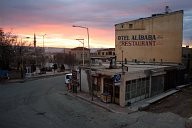
A Cappadocian village
Manoël Pénicaud / Le Pictorium
LePictorium_0169816.jpg
Known in Islam as the People of the Cave
(Ahl al-Kahf in Arabic), the Seven Sleepers are said to have miraculously slept for several centuries in a cave in order to escape from the persecutions of the Roman Empire. Their awakening is a metaphor for the resurrection
of the body, in both Christianity and in Islam
(Qur’anic sura ‘The Cave’). The narratives
of the Seven Sleepers were widely disseminated. Numerous caves in the Mediterranean region are considered to be sacred places where this miracle occurred. This legend has sometimes given rise to joint veneration by Christians and Muslims.
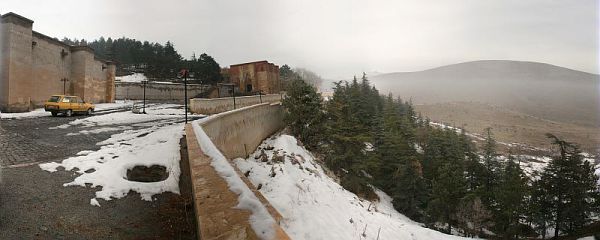
Old caravanserai of the Seven Sleepers in Afsin, on the border of Kurdistan in Turkey
Manoël Pénicaud / Le Pictorium
LePictorium_0169817.jpg
The site formerly cohabited with a church.
Known in Islam as the People of the Cave (Ahl al-Kahf in Arabic), the Seven Sleepers are said to have miraculously slept for several centuries in a cave in order to escape from the persecutions of the Roman Empire. Their awakening is a metaphor for the resurrection of the body, in both Christianity and in Islam (Qur’anic sura ‘The Cave’). The narratives of the Seven Sleepers were widely disseminated. Numerous caves in the Mediterranean region are considered to be sacred places where this miracle occurred. This legend has sometimes given rise to joint veneration by Christians and Muslims.
Known in Islam as the People of the Cave (Ahl al-Kahf in Arabic), the Seven Sleepers are said to have miraculously slept for several centuries in a cave in order to escape from the persecutions of the Roman Empire. Their awakening is a metaphor for the resurrection of the body, in both Christianity and in Islam (Qur’anic sura ‘The Cave’). The narratives of the Seven Sleepers were widely disseminated. Numerous caves in the Mediterranean region are considered to be sacred places where this miracle occurred. This legend has sometimes given rise to joint veneration by Christians and Muslims.

Fountain with the Turkish names of the Seven Sleepers in an old caravanserai on the Silk Road
Manoël Pénicaud / Le Pictorium
LePictorium_0169818.jpg
Known in Islam as the People of the Cave
(Ahl al-Kahf in Arabic), the Seven Sleepers are said to have miraculously slept for several centuries in a cave in order to escape from the persecutions of the Roman Empire. Their awakening is a metaphor for the resurrection
of the body, in both Christianity and in Islam
(Qur’anic sura ‘The Cave’). The narratives
of the Seven Sleepers were widely disseminated. Numerous caves in the Mediterranean region are considered to be sacred places where this miracle occurred. This legend has sometimes given rise to joint veneration by Christians and Muslims.
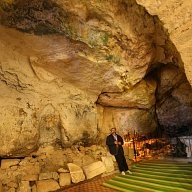
Cave of the Seven Sleepers in Afsin
Manoël Pénicaud / Le Pictorium
LePictorium_0169819.jpg
Known in Islam as the People of the Cave
(Ahl al-Kahf in Arabic), the Seven Sleepers are said to have miraculously slept for several centuries in a cave in order to escape from the persecutions of the Roman Empire. Their awakening is a metaphor for the resurrection
of the body, in both Christianity and in Islam
(Qur’anic sura ‘The Cave’). The narratives
of the Seven Sleepers were widely disseminated. Numerous caves in the Mediterranean region are considered to be sacred places where this miracle occurred. This legend has sometimes given rise to joint veneration by Christians and Muslims.

Bus station in winter
Manoël Pénicaud / Le Pictorium
LePictorium_0169820.jpg
Known in Islam as the People of the Cave
(Ahl al-Kahf in Arabic), the Seven Sleepers are said to have miraculously slept for several centuries in a cave in order to escape from the persecutions of the Roman Empire. Their awakening is a metaphor for the resurrection
of the body, in both Christianity and in Islam
(Qur’anic sura ‘The Cave’). The narratives
of the Seven Sleepers were widely disseminated. Numerous caves in the Mediterranean region are considered to be sacred places where this miracle occurred. This legend has sometimes given rise to joint veneration by Christians and Muslims.

Wishing Tree in Afsin
Manoël Pénicaud / Le Pictorium
LePictorium_0169821.jpg
Known in Islam as the People of the Cave
(Ahl al-Kahf in Arabic), the Seven Sleepers are said to have miraculously slept for several centuries in a cave in order to escape from the persecutions of the Roman Empire. Their awakening is a metaphor for the resurrection
of the body, in both Christianity and in Islam
(Qur’anic sura ‘The Cave’). The narratives
of the Seven Sleepers were widely disseminated. Numerous caves in the Mediterranean region are considered to be sacred places where this miracle occurred. This legend has sometimes given rise to joint veneration by Christians and Muslims.

 the People of the Cave
/ Manoel Penicaud
the People of the Cave
/ Manoel Penicaud